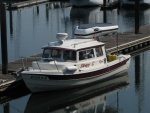Esmi2
Member
- Joined
- Aug 26, 2016
- Messages
- 103
- Reaction score
- 4
- C Dory Year
- 2006
- C Dory Model
- 23 Venture
- Hull Identification Number
- GXK23009K506
On the internet, I am looking at the chain locker area of a C-22, and I note a series of patches in the fiberglass just below the hull/deck joint.
The patches are located in a position that they seem as if they are part of the backing for the rub rail.
My question is, "is this factory work?" It seems different than the hull penetrations and backing for the stantions and the windlass.
Can anyone tell me what I am looking at?
http://www.c-brats.com/modules.php?...ame=gallery&file=index&include=view_photo.php
Thanks!
The patches are located in a position that they seem as if they are part of the backing for the rub rail.
My question is, "is this factory work?" It seems different than the hull penetrations and backing for the stantions and the windlass.
Can anyone tell me what I am looking at?
http://www.c-brats.com/modules.php?...ame=gallery&file=index&include=view_photo.php
Thanks!

